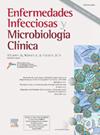Spatial analysis for risk assessment of dengue in Spain
IF 2.6
4区 医学
Q3 INFECTIOUS DISEASES
Enfermedades infecciosas y microbiologia clinica
Pub Date : 2024-10-01
DOI:10.1016/j.eimc.2023.06.010
引用次数: 0
Abstract
Introduction
The establishment of Aedes albopictus in new areas in Europe has changed the risk of local dengue transmission represented by imported human cases. The risk of transmission is determined by the distribution of travelers arriving from dengue-endemic areas and the distribution of Ae. albopictus as potential vectors of dengue in Spain.
Methods
Environmental, entomological, epidemiological, demographic, tourism and travel data were analyzed to produce a series of maps to represent: the distribution of Ae. albopictus across municipalities; the risk of expansion of Ae. albopictus based on a species distribution model; the calculated index of travelers from dengue-endemic areas (IDVZE) per province; the percentage contribution of each municipality to the total number of cases in Spain. The maps were then added using map algebra, to profile the spatial risk of autochthonous dengue in Spain at a municipal level from 2016 to 2018.
Results
Ae. albopictus was detected in 983 municipalities. The calculated IDVZE varied from 0.23 to 10.38, with the highest IDVZE observed in Madrid. The overall risk of autochthonous cases oscillated between 0.234 and 115, with the very high risk and high risk areas detected in the Mediterranean region, mainly in the Levantine coast and some parts of the Balearic Islands. Most of the interior of the peninsula was characterized as low risk.
Conclusion
Prevention and control measures to mitigate the risk of autochthonous dengue should be prioritized for municipalities in the high risk areas integrating early detection of imported dengue cases and vector control.
西班牙登革热风险评估的空间分析
导言:白纹伊蚊在欧洲新地区的出现改变了由输入性人类病例所代表的登革热在当地传播的风险。传播风险取决于从登革热流行地区来的旅行者的分布情况,以及作为登革热潜在病媒的白纹伊蚊在西班牙的分布情况。白蛉在各市的分布情况;根据物种分布模型得出的白蛉扩展风险;计算得出的各省登革热流行区游客指数(IDVZE);各市占西班牙病例总数的百分比。然后,利用地图代数将这些地图相加,勾勒出2016年至2018年西班牙市镇一级的自体登革热空间风险。计算得出的 IDVZE 从 0.23 到 10.38 不等,马德里的 IDVZE 最高。自生病例的总体风险在 0.234 至 115 之间波动,在地中海地区发现了极高风险和高风险地区,主要在黎凡特海岸和巴利阿里群岛的部分地区。结论对于高风险地区的城市来说,应优先采取预防和控制措施,以降低自生登革热的风险,其中包括及早发现输入性登革热病例和病媒控制。
本文章由计算机程序翻译,如有差异,请以英文原文为准。
求助全文
约1分钟内获得全文
求助全文
来源期刊
CiteScore
2.10
自引率
8.00%
发文量
194
审稿时长
29 days
期刊介绍:
Hoy está universalmente reconocida la renovada y creciente importancia de la patología infecciosa: aparición de nuevos agentes patógenos, de cepas resistentes, de procesos con expresión clínica hasta ahora desconocida, de cuadros de una gran complejidad. Paralelamente, la Microbiología y la Infectología Clínicas han experimentado un gran desarrollo como respuesta al reto planteado por la actual patología infecciosa. Enfermedades Infecciosas y Microbiología Clínica es la Publicación Oficial de la Sociedad Española SEIMC. Cumple con la garantía científica de esta Sociedad, la doble función de difundir trabajos de investigación, tanto clínicos como microbiológicos, referidos a la patología infecciosa, y contribuye a la formación continuada de los interesados en aquella patología mediante artículos orientados a ese fin y elaborados por autores de la mayor calificación invitados por la revista.

 求助内容:
求助内容: 应助结果提醒方式:
应助结果提醒方式:


